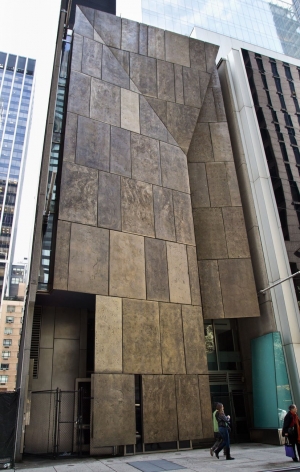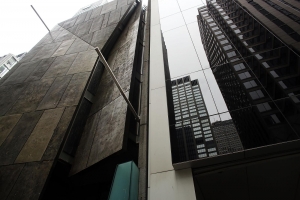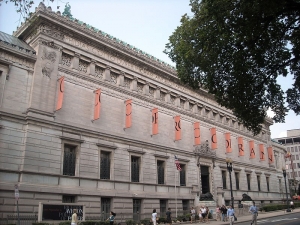|
Displaying items by tag: facade
The Huntington Library, Art Collections, and Botanical Gardens announced Wednesday that the front portion of its new Steven S. Koblik Education and Visitor Center will open Jan. 14.
A new entrance facade will be flanked by an arrival court filled with California pepper trees and framed by grapevines. A new admissions and membership building will have lockers, an ATM and new restrooms. Other new visitor amenities at the San Marino museum and gardens will include a simple coffee shop serving sandwiches and salads and a 5,000-square-foot store.
Padua’s celebrated Scrovegni Chapel, which houses exceptional frescoes by trecento painter and architect Giotto, was struck by a bolt of lightning on August 9.
The iron cross on the facade was seriously damaged and subsequently removed. The entire electrical system was temporarily knocked offline. The Gazetta del Sud also reports the damage of outside stones.
According to Il Secolo XIX, the news was broken almost three weeks after the event by the local association “the Amissi Piovego.” The group raised the alarm before any statement from city hall was released.

Perhaps there is no better symbol of the clout of Aspen’s art world habitués than the new Aspen Art Museum. Opening to the public August 9, following a weekend of preview parties, the museum’s latest home was designed by Pritzker prize winner Shigeru Ban, who has created a shimmering three-story building resembling a wooden crate in the center of town. Its striking latticework façade, with a woven wooden screen covering a glass curtain wall, not only lets the light in, but affords passersby a glimpse inside. Each of its many apertures is unique, “a great metaphor for art,” Heidi Zuckerman Jacobson, the museum’s director, noted as she led me on a hard hat tour the other day, pointing out the Japanese architect’s love of such materials as cardboard tubes, recycled paper and wood. “Shigeru dislikes monumental architecture, “ she said. “You won’t find any marble in here.” The museum is Ban’s first in the U.S. He is best known for his humanitarian projects designing shelters after natural disasters in such places as Japan, Rwanda and Haiti.
The Philadelphia Museum of Art and architect Frank Gehry have unveiled a comprehensive renovation and expansion plan for the institution’s landmark building. Thanks to the exhibition “Classic Modern: Frank Gehry’s Master Plan for the Philadelphia Museum of Art,” visitors can catch a glimpse of the design, which involves adding 78,000-square-feet of gallery space to the museum without altering its celebrated facade. Through large-scale models, site plans, and renderings, the exhibition will help patrons visualize and understand the plan that Gehry has been developing with his creative team since 2006.
While Gehry is best known for his expressive, sculptural buildings, such as the curvilinear Guggenheim Museum in Bilbao, Spain, his approach to the Philadelphia Museum of Art is considerably less dramatic. The project involves transforming the museum’s interior by renewing beloved spaces, such as the Great Stair Hall, and improving how visitors enter and move through the institution.

On Monday, April 14, workers began placing scaffolding and protective netting around the former home of the American Folk Art Museum on West 53rd Street in New York City. Last week, the Museum of Modern Art, which acquired the Tod Williams and Billie Tsien-designed building in 2011 after the Folk Art Museum defaulted on more than $30 million in bond debt, filed plans with the city’s Department of Buildings for a partial demolition. MoMA made the controversial decision to raze the building last April.
Before demolition can begin, the Folk Art Museum’s striking bronze facade must be disassembled and stored. MoMA has made no further decisions about what will happen to the facade beyond its preservation. Demolition of the remaining structure is expected to last through the summer.
The former Folk Art Museum will be leveled to create space for MoMA's upcoming expansion. The project is being helmed by the architecture firm Diller Scofidio + Renfro and will include a renovation of the museum’s main building. The new site will join MoMA’s existing galleries with a forthcoming 82-story residential tower, which will include exhibition space for the museum.

Twelve years ago, the Folk Art Museum erected a monumental flagship building next door to the Museum of Modern Art on West 53rd Street in Manhattan. In 2011, after a spate of financial troubles, the Folk Art Museum decided to sell the building to MoMA and move to a smaller outpost. Now, the MoMA is planning to demolish the building to make way for an expansion that will connect to a new tower on the other side of the former Folk Art Museum.
The building, which was designed by notable New York-based architects Tod Williams and Billie Tsien and features a sculptural bronze façade, has become a Midtown landmark in a short amount of time. However, MoMA officials decided that the building didn’t mesh well with the museum’s glass façade; it is also set back further than MoMA’s structure, making expansion logistics difficult.
MoMA’s new 82-story building will be designed by French architect Jean Nouvel and constructed by Hines, a Houston-based company. The new structure will include apartments and about 40,000 square feet of gallery space. The Folk Art Museum’s former space will provide an additional 10,000 square feet of exhibition space. The renovation is expected to begin in 2014 by which time the Folk Art Museum’s former home will be leveled.

Fans are breathing a sigh of relief after Washington, D.C.’s Corcoran Gallery of Art decided against selling its historic Beaux-Arts home and moving to the suburbs. The cash-strapped institution shocked fans with the proposal, which was announced this summer. Ultimately, the Corcoran’s board of trustees decided that the museum and its associated College of Art and Design, which is in close proximity to the White House, should stay put.
Designed by Ernest Flagg, the Corcoran Gallery opened to the public in 1897 and remains the largest privately supported cultural institution in Washington, D.C. The museum, which specializes in American art, is currently in need of $130 million worth of renovations. While the institution’s façade was restored last year, the galleries are still in need of a major overhaul, which is the main reason why Corcoran officials were considering the sale to begin with.
Although the institution has been struggling financially for years, strong reaction to the potential move has proved inspirational. The Corcoran is considering embarking on partnerships with like-minded institutions and collaborations with other D.C. museums, including the National Gallery of Art, have been explored.
|
|
|
|
|